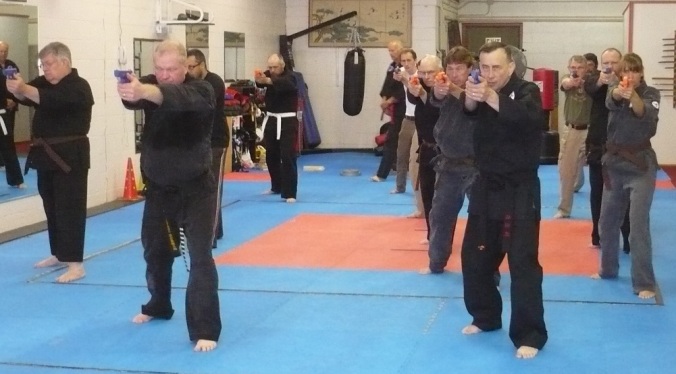 Show any twelve- year- old in America a set of nunchaku, a kama, or a tonfa, and ask him what they are, and you will get an enthusiastic reply: “Karate weapons!” I remember watching a Bruce Lee movie with my wife, who commented, “If I were fighting that many bad guys, I think I would find a better weapon than a nunchaku.” My wife was certainly correct. The nunchaku isn’t a very good weapon; in fact, it isn’t a weapon at all.
Show any twelve- year- old in America a set of nunchaku, a kama, or a tonfa, and ask him what they are, and you will get an enthusiastic reply: “Karate weapons!” I remember watching a Bruce Lee movie with my wife, who commented, “If I were fighting that many bad guys, I think I would find a better weapon than a nunchaku.” My wife was certainly correct. The nunchaku isn’t a very good weapon; in fact, it isn’t a weapon at all.
So thoroughly has the Hollywood and Hong Kong mythology filled the American mind, few realize that all three of the above mentioned “Karate Weapons” were originally designed as farming tools.
Most of the martial arts weapons tradition comes to us from the islands of Okinawa, which were conquered in 1609 by the Satsuma samurai clan of Japan. One of the first acts of the new overlords was to outlaw the ownership of weapons by the natives. Being thus unable to train with swords, bows, and spears, the Okinawans developed the martial art of Kobudo, learning to use farming tools as weapons. While any of these brave Okinawan warriors would have preferred a sword, a grain flail, a scythe, and a mill handle became, in the hands of a trained practitioner, formidable weapons.
As much as I respect these weapons and believe they should be studied from a historical and scholarly standpoint (just as the flintlock rifle should be studied), none of them would be my weapon of choice when facing a deadly opponent.
In some ways, our situation in America is not dissimilar from that of seventh- century Okinawa. We have laws which prevent private citizens from owning and training with the most effective, military grade weapons. We are forbidden from owning automatic weapons, mortars, claymore mines, and rocket launchers, just to name a few. A private citizen can, however, poses and carry a handgun in every state of the union. Thus, like the Okinawans of old, we train with a weapon so impotent that modern militaries do not even give them serious consideration. Yet, like the nunchaku, with enough training, even the handgun can be a formidable weapon.
While most westerners tend to think of the samurai as sword warriors, muskets were introduced to Japan during the samurai period of history, and after the battle of Nagashino, the musket became an important weapon in Japan, where the formal study of musketry and artillery was called Hojutsu, or fire art. As the Japan began build a modern military in the end of the nineteenth century, the term fell into disuse.
Once Eastern martial arts came to America, it was only a matter to time until someone decided to apply the dojo method to the study of the hand gun. The first person to do this in a serious way was Jeff Hall, a legendary figure in the Alaska State Troopers, and a traditional martial artist. Hall was inspired when he saw how quickly traditional martial artists, being accustomed to disciplined study, were able to master the handgun, and set about to revive the old art.
The modern revival of Hojutsu enfolds all modern weapons and techniques in a continuum of use-of-force options running from empty hand techniques, through knife and cane, to handgun, and on to shotgun and precision rifle. These techniques are taught from a disciplined, dojo perspective, emphasizing precise repetition of movements. The handgun is the entry point of Hojutsu, as it is the most available both for defense and training in America.
The handgun is taught as only one of many options to be deployed in self-defense. Most firearms schools will teach that there is a time not to use force, but Hojutsu is one of the few that teaches the use of a level of force less than that of a hand gun. How many dangerous encounters might have been better handled with a fist than a gun?
Hojutsu is a thinking man’s practice. You won’t hear Jeff Hall use the words “always” and “never” very much. He likes to say that the answer to every gun fighting question is, “It depends”. When you study Hojutsu, you can expect thoughtful discussions about the solutions to gun fighting problems. For instance, if you are shooting around the left side of cover, should you shoot left handed? Jeff Hall’s answer is, “It depends. If you shoot with the same speed and accuracy left handed as you do right, yes, it would be foolish to expose any more of your body than necessary; but, if you shoot slower, or less accurately, it might be better shoot right handed, even if that means exposing more of yourself to incoming fire.” That conversation is a good example of Jeff Hall’s gun fighting philosophy, which I would summarize thus: “Movement, use of cover, scanning, reloads and malfunction drills are all important, but the most efficient way to win a gunfight is to put rounds on target with speed and precision.” Just as any good Sensei spends more time teaching his students the straight punch than the much more exciting two-step-flying-side kick, Hall spends more time teaching accurate, fast shooting than many of the fancier techniques that make for exciting promotional videos. This is not to say that Hojutsu is a simple art; rather, in the dojo tradition, students are challenged to strive for mastery of the complex through precise application of the fundamentals.
For more information about Hojutsu, go to http://www.hojutsu.com